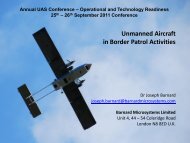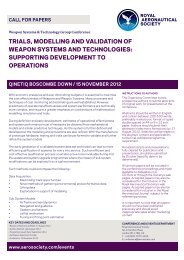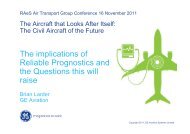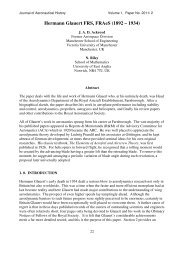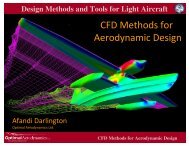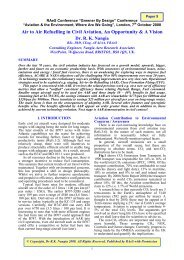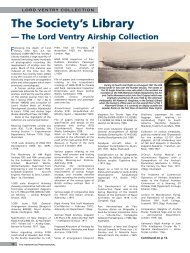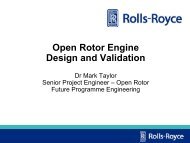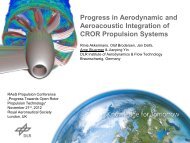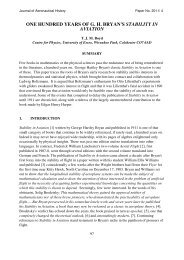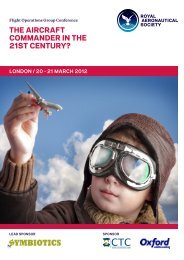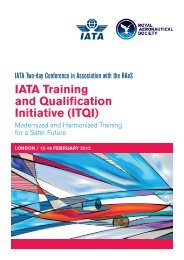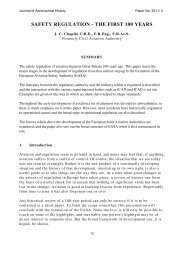Smoke, Fire and Fumes in Transport Aircraft - Royal Aeronautical ...
Smoke, Fire and Fumes in Transport Aircraft - Royal Aeronautical ...
Smoke, Fire and Fumes in Transport Aircraft - Royal Aeronautical ...
Create successful ePaper yourself
Turn your PDF publications into a flip-book with our unique Google optimized e-Paper software.
NASA REPORT ON THE TYPOGRAPHY OF FLIGHTDECK DOCUMENTATION<br />
by Asaf Degani of the San Jose State University Foundation, San Jose, California. This NASA document was prepared <strong>in</strong> December 1992 for<br />
the National Aeronautics <strong>and</strong> Space Adm<strong>in</strong>istration, Ames Research Center, Moffett Field, California 94035-1000, under Contract NCC2-327.<br />
List of Design Recommendations (Extract)<br />
This section lists together all the design recommendations from the previous sub-sections. These recommendations are not specifications.<br />
They only form a basel<strong>in</strong>e, which is based exclusively on the author's subjective <strong>in</strong>terpretation of the data. Each recommendation should be<br />
carefully evaluated by the designer based on the type of documentation, usage, criticality, <strong>and</strong> the target population. The recommendations<br />
are listed accord<strong>in</strong>g to the order of sections <strong>in</strong> the report (sub-section numbers are given <strong>in</strong> parenthesis):<br />
1. Sans-serif fonts are usually more legible than fonts with serifs (3.2)<br />
2. Avoid us<strong>in</strong>g a font that has characters that are too similar to one another, as this will reduce the legibility of the pr<strong>in</strong>t. (3.2)<br />
3. Avoid us<strong>in</strong>g dot matrix pr<strong>in</strong>t for critical flight-deck documentation. (3.2)<br />
4. Long chunks of text should be set <strong>in</strong> lower case. (3.3)<br />
5. If upper case is required, the first letter of the word should be made larger <strong>in</strong> order to enhance the legibility of the word. (3.3)<br />
6. When specify<strong>in</strong>g font height, or access<strong>in</strong>g graphs to determ<strong>in</strong>e the size of a lower-case character, the dist<strong>in</strong>ction between ‘x’ height <strong>and</strong><br />
overall size should be made. (3.4)<br />
7. As a general recommendation, the ‘x’ height of a font used for important flight-deck documentation should not be below 0.10 <strong>in</strong>ch. (3.4)<br />
8. The recommended height-to-width ratio of a font that is viewed <strong>in</strong> front of the observer is 5:3. (3.5)<br />
9. The vertical spac<strong>in</strong>g between l<strong>in</strong>es should not be smaller than 25-33% of the overall size of the font. (3.6)<br />
10. The horizontal spac<strong>in</strong>g between characters should be 25% of the overall size <strong>and</strong> not less than one stroke width. (3.6)<br />
11. Avoid us<strong>in</strong>g long str<strong>in</strong>gs of text set <strong>in</strong> italics. (3.8)<br />
12. Use primarily one or two typefaces for emphasis. (3.8)<br />
13. Use black characters over a white background for most cockpit documentation. (3.9)<br />
14. Avoid us<strong>in</strong>g white characters over a black background <strong>in</strong> normal l<strong>in</strong>e operations (3.9). However, if this is desired:<br />
a.. Use m<strong>in</strong>imum amount of text.<br />
b.. Use relatively large type size.<br />
c. Use sans-serif to m<strong>in</strong>imise the loss of legibility.<br />
15. Black over white or yellow are recommended for cockpit documentation. (3.10)<br />
16. Avoid us<strong>in</strong>g black over dark red, green, <strong>and</strong> blue. (3.10)<br />
17. Use anti-glare plastic to lam<strong>in</strong>ate documents. (4.1)<br />
18. Ensure that the quality of the pr<strong>in</strong>t <strong>and</strong> the paper is well above normal st<strong>and</strong>ards. Poor quality of the pr<strong>in</strong>t will effect legibility <strong>and</strong><br />
readability. (4.3)<br />
19. The designer must assess the age groups of the pilots that will be us<strong>in</strong>g the documentation, <strong>and</strong> take a very conservative approach <strong>in</strong><br />
assess<strong>in</strong>g <strong>in</strong>formation obta<strong>in</strong>ed from graphs <strong>and</strong> data books. (4.4)<br />
60<br />
<strong>Smoke</strong>, <strong>Fire</strong> <strong>and</strong> <strong>Fumes</strong> <strong>in</strong> <strong>Transport</strong> <strong>Aircraft</strong><br />
End of NASA recommendations on typography<br />
END OF APPENDIX 5



